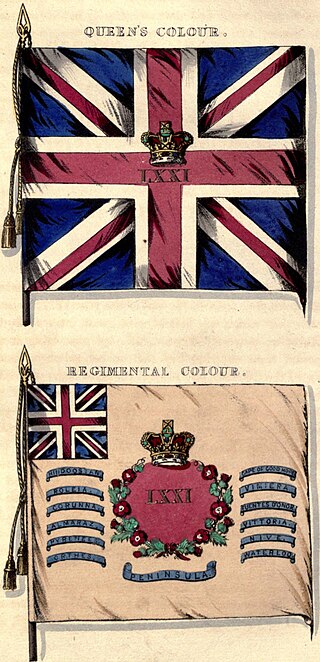Related Research Articles

The 71st Regiment of Foot was a Highland regiment in the British Army, raised in 1777. Under the Childers Reforms it amalgamated with the 74th (Highland) Regiment of Foot to become the 1st Battalion, Highland Light Infantry in 1881.
The 134th Regiment of Foot was an infantry regiment of the British Army, created in 1794 and disbanded in 1796. The regiment was formed in Ireland by redesignating the newly raised 2nd Battalion of the 83rd Regiment of Foot, and did not leave Ireland before being disbanded in 1796.
The 69th Regiment of Foot was an infantry regiment of the British Army, raised in 1756. Under the Childers Reforms it amalgamated with the 41st (Welch) Regiment of Foot to form the Welch Regiment in 1881.
The 130th Regiment of Foot was an infantry regiment of the British Army, created in 1794. After being raised it was sent to the West Indies, where it suffered heavy losses from tropical disease. The unit was disbanded at Santo Domingo in 1796, with the survivors drafted into other regiments.
The 129th Regiment of Foot was an infantry regiment of the British Army. It was created in 1794 and disbanded in 1796. The regiment was raised at Coventry, and was originally titled the Gentlemen of Coventry's Regiment of Foot, being retitled the 129th a few days later.
The 125th Regiment of Foot was an infantry regiment of the British Army, created in 1794 and disbanded in 1796. It was raised at Stamford, Lincolnshire, under the colonelcy of Newton Treen.

The 30th (Cambridgeshire) Regiment of Foot was an infantry regiment of the British Army, raised in 1702. Under the Childers Reforms it amalgamated with the 59th Regiment of Foot to form the East Lancashire Regiment in 1881.
The 116th Regiment of Foot was an infantry regiment of the British Army, formed in 1793 and disbanded in 1795, with some personnel sent to the 42nd Highlanders.
The 75th Regiment of Foot (Invalids) was an infantry regiment of the British Army from 1762 to 1768. It was originally raised as a regiment of invalids in June 1762, by John Lind, and numbered the 118th Foot; it was renumbered as the 75th the following year, and disbanded in 1768 or 1769.
The 114th Regiment of Foot was an infantry regiment of the British Army from 1794 to 1795. It was raised in April 1794 and was disbanded the following year.
The 114th Regiment of Foot (Royal Highlander Volunteers) was an infantry regiment of the British Army from 1761 to 1763.It was raised in October 1761, by Sir Allan MacLean of Torloisk. He was commissioned lieutenant in the 60th Foot Royal Americans at the beginning of the Seven Years' War and was severely wounded at Ticonderoga in 1758. He was then given one of the four NY Independent Companies until he returned to Scotland where he raised the 114th Maclean's Highlanders, or the Royal Highland Volunteers, as their Major Commandant. The regiment was disbanded in 1763.
The 109th Regiment of Foot (Bombay Infantry) was an infantry regiment of the British Army from 1862 to 1881, when it was amalgamated into The Prince of Wales's Leinster Regiment (Royal Canadians).
The 108th Regiment of Foot (Madras Infantry) was an infantry regiment of the British Army. However, it was raised initially as part of the Madras Army, by the East India Company (EIC) in 1766.
The 113th Regiment of Foot was an infantry regiment of the British Army from 1794 to 1795.
The 110th Regiment of Foot was an infantry regiment of the British Army from 1794 to 1795.
The 110th Regiment of Foot (Queen's Royal Musqueteers) was an infantry regiment of the British Army from 1761 to 1763.
The 109th Regiment of Foot was an infantry regiment of the British Army from 1761 to 1763.
The 107th Regiment of Foot was an infantry regiment of the British Army, raised by the East India Company in 1765. Under the Childers Reforms, it amalgamated with the 35th Regiment of Foot to form the Royal Sussex Regiment.

The 49th (Hertfordshire) Regiment of Foot was a line infantry regiment of the British Army, raised in 1743. Under the Childers Reforms it amalgamated with the 66th (Berkshire) Regiment of Foot to form the Princess Charlotte of Wales's in 1881.
References
- ↑ "127th Regiment of Foot". regiments.org. Archived from the original on 16 October 2007.